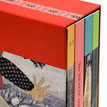| Marcin Ramocki |
Making
8 BIT |
8 BIT was born in the East Village bar Open Air, which used
to host Share, a monthly gathering of computer musicians,
geeks by choice, and people interested in computer art in
general. At that time, I was really into chiptune music,
curating performances at vertexList, and trying to check out
all the related events happening in the city. Chiptunes are
musical pieces created with old computers or game decks
with internal sound synthesizers. For example, Commodore
64, Atari, Nintendo Entertainment System (NES) and Game
Boy, all mostly created using 8 bit. As I became more and
more familiar with this little scene of musicians, demo people,
and hackers of all kinds, I realized that there was a huge
cultural potential in games, both old and new. Affected by
too many cocktails, I decided to make a documentary.
Of course nobody
took my claim seriously, since I am known to make grandiose alcoholic
statements that often translate into nothing much at all. But this time
I was firm in my intentions. The phenomenon was genuinely exciting and
unique, and I quickly realized that the folks using Game Boys to compose/perform
music were so exotic that to just show them playing music, without a deeper
investigation, wouldn’t do much good. I had to get into cracking
games, the demo scene,
original chiptunes and many other things I didn’t even anticipate.
One discovery led to another until the scope of the project grew and
changed. The final topic of the project was music and art influenced by
video
games. Suddenly the visual arts became as much a part of the equation as
music, which was only a natural progression: demos were both visual and
sound pieces.
I started out with the music people: Bit Shifter, Bubblyfish,
Glomag, Nullsleep, and Bodenstandig 2000 (who, luckily for me, came to
play at Deitch Projects in Soho, NYC). Later I managed to talk to Role
Model (aka Johan Kotlinski from Stockholm, the author of Little Sound
DJ, a tracker software for making music on Game Boys), Teamtendo from
Paris (two guys dressed in animal costumes who love to assault camera
men), the Treewave duo from Dallas and Gameboyz Orchestra from Poland.
The music content naturally divided itself into three chapters: Demo Scene,
Chiptunes and Game Boy.
Demo
scene is
the root of many of today’s new media ideas. It started
in the early ’80s in Europe, with teenage game crackers who replaced
the
64 Kb used for the disc copy protection with their own custom animation
and sound. These demos soon became quite sophisticated, and hackers pitted
their productions against one another. Chiptune is the sound accompanying
a demo: It is music made through an internal 8 bit sound chip. In
fact, all early video game music was chiptunes. It was only in 1999 when
the first chiptune records came out: “Maxi German Rave Hits 3” by
Bodenstandig 2000 in Germany and “8-Bit Construction Set” by
Beige
Records (Cory Arcangel) here in the US. Game Boy music is a form of chiptune
but for less computer-savvy musicians. The platform was made accessible
by Johan Kotlinski’s LSDJ in 2000 and Oliver Witchoff’s Nanoloop
(2000). Ever since then, musicians have been rocking out to their Game
Boys all over the world, especially in Vienna, Stockholm, NYC and Tokyo.
—
MARCIN RAMOCKI is a new media artist and curator based in Williamsburg,
Brooklyn. His work involves software art projects, generative and interactive
media
installations as well as web-based projects. He is a founder of vertexList
space in
Brooklyn and an instructor of new media arts at the New Jersey City University.
Marcin’s first feature-length documentary 8
BIT will premiere at
MoMA in October
2006. For more info on his work please visit www.ramocki.net.
For the complete article purchase The Sienese Shredder #1
Back to The Sienese Shredder #1
| 

